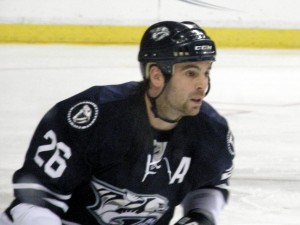
The date was February 22, 2007. Steve Sullivan, then a member of the Nashville Predators, was facing off against arguably the greatest franchise in National Hockey League history, the Montreal Canadiens. Odds had been stacked against Sullivan for nearly his entire career, and they were about to make yet another unwanted appearance in his life. He would severely injure his back in that game against the Habs, and it was beginning to look like Steve Sullivan had played his final game of professional hockey.
Junior Hockey
A native of Timmins, Ontario, Sullivan grew up loving the game of hockey. It became clear at a young age that he was much better than your average teenager skating around on the local rink. In the 1992-1993 season, Sullivan would suit up for the Timmins Golden Bears of the NOJHA. He would play 47 games for the Golden Bears that year, and put up an amazing 121 points, including an astounding 66 goals. Clearly, he was ready for the next step up. Sullivan would play for the Sault Ste. Marie Greyhounds of the Ontario Hockey League the following season, and put up a very solid 63 points in 62 games in his rookie year in the OHL.
As if he hadn’t quieted those who doubted him because of his size, Sullivan would finish the 1993-1994 season with the Greyhounds with 101 points in just over sixty games to lead the team in scoring. The Greyhounds had multiple future NHL players on that year’s team such as Dan Cloutier and Aaron Gavey, and they were also coached by future NHL head coach, Ted Nolan.
What The Stats Mean
Now, there’s reason I just threw a bunch of numbers and statistics at you. Let’s look at the 1994 NHL Draft. Aaron Gavey recorded nine points fewer than Sullivan in Sullivan’s draft year. However, Gavey was selected in the fourth round of the draft, 74th overall by the Tampa Bay Lightning, two years earlier. Steve Sullivan would be selected in the ninth round, 233rd overall by the New Jersey Devils. Why you ask, was Gavey deemed to be so much better of a talent, that he would be selected 159 spots ahead of where Sullivan would go in two years time? Simple, really. It all comes down to one word: size.

Gavey was 6’2″, and almost 200 pounds; Sullivan was about 5’9″”, and he was at least 40 pounds lighter than Aaron Gavey. Right from the start, Sullivan had a smaller chance of becoming a pro hockey player than the majority of players around him, regardless of skill level or potential. Clearly, he beat all the odds. They were stacked way over his head, and his chances of fulfilling his dream were somewhere between slim and none. However, there’s a reason he conquered the wall of odds and made those dreams reality: Steve Sullivan found the ladder.
Climbing The Ladder
Sullivan made his NHL debut in the 1995-1996 season with the Devils, but spent the majority of the year in the American Hockey League with the Albany River Rats. The AHL was still a level he could dominate in, as he put up 75 points in 53 games. He was named to the league’s first all-star team, and won a Calder Cup with Albany. Sullivan would also put up some solid numbers with the Devils in the 1996-1997 season. It was beginning to look like he could actually play a high level of professional hockey, but just not with New Jersey. The Devils acquired Dave Ellett, Doug Gilmour and a 3rd round draft selection from the Toronto Maple Leafs in exchange for Jason Smith, Sullivan, and the rights to Alyn McCauley.
The trade would turn out the be the big break that Sullivan needed. With Gilmour no longer in the Leafs’ lineup, Sullivan would play 21 games for Toronto that season. He would also play the following three seasons in a Leafs uniform. Sullivan had proven the doubters wrong, and shown that he could be a full-time National Hockey League player.
Reaching The Top Step
The Maple Leafs would eventually move on from Sullivan, placing him on waivers at the start of the 1999-2000 season. He was claimed by the Chicago Blackhawks, and Sullivan would have some of the most productive seasons of his pro career in the Windy City. The 2000-2001 season was the best point-producing year Sullivan has had, as he tallied a career-high 75 points, including a career-high in goals with 34. Sullivan would record over 300 points in a Blackhawks uniform in five seasons. Once again, however, Sullivan would move on to a new team. Chicago would trade Sullivan to the Nashville Predators in February of 2004, in exchange for two second-round draft picks. He would score three goals for the Preds in his Nashville debut, but unfortunately, his career slowly began to slide downhill from there.
The Courage Peaks
With the NHL lockout occurring in 2004-2005, the way the NHL was played, changed. Suddenly, smaller players like Steve Sullivan could fly around the ice without worrying about being obstructed. He would have a good year in the season following the lockout, but the 2006-2007 season would really put his courage to the test. The injury to his back was devastating, and it appeared that his days playing pro hockey were numbered. He would undergo two surgeries, and began rehabilitation that was filled with setbacks.

Nevertheless, Sullivan would make his return to the Predators’ lineup after missing a total of 153 games, and sitting out for 678 days. He would make his return to the ice on January 11, 2009, against his former team, the Chicago Blackhawks. The comeback earned Sullivan the National Hockey League’s 2009 Bill Masterton Trophy, which is awarded annually to the player who “best exemplifies the qualities of perseverance, sportsmanship and dedication to hockey.” His courageousness also earned Sullivan the respect of hockey fans across the globe.
Injuries would appear in his life again in the 2010-2011 season, as sports hernia surgery would really limit his games. It would ultimately spell the end of his time in Nashville. In the summer of 2011, Sullivan signed as an unrestricted free agent with the Pittsburgh Penguins, where has since served in a leadership role. His well-known craftiness and speed has helped him continue to play at the highest level, and he continues to be a role model for young players. When he signed with the Pens, general manager Ray Shero had this to say about Sullivan’s game:
“He’s a right-hand shot that plays the off side and can play up high as well. He’s got really good speed and is a very smart player. He can play with good players as well.”
With injuries appearing to be a part of the past, the 37 year-old Sullivan knows his playing days are coming to an end. To reach 1000 games, Sullivan would have to play another season, and he’s also closing in on 600 career points.
However, even if he doesn’t reach those milestones, Steve Sullivan is still the star of one of the most inspirational comeback stories the NHL has ever seen.
________________________________________________
Follow me on Twitter: @DavidOConnor95 “Like” my page on Facebook: David O’Connor